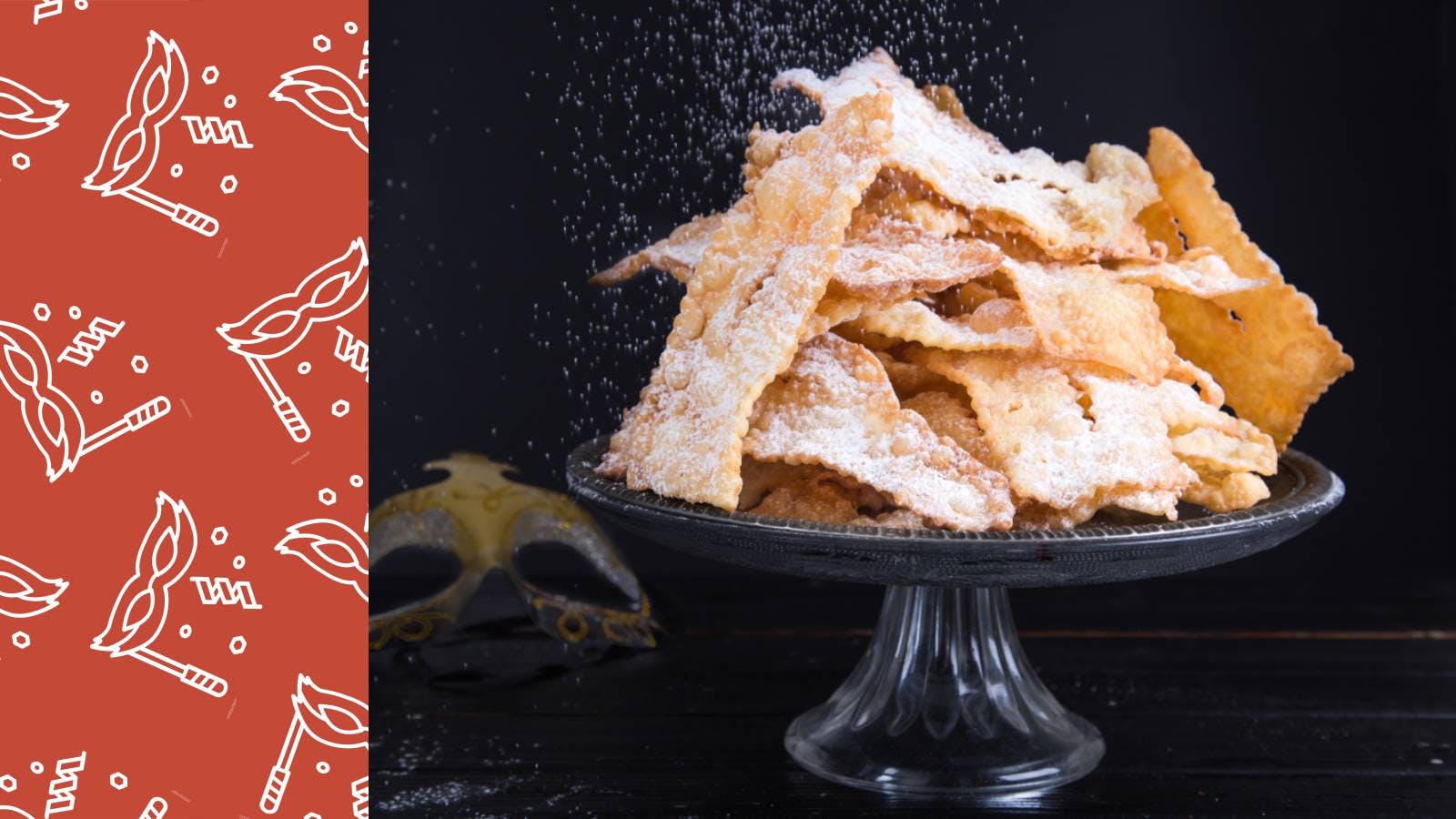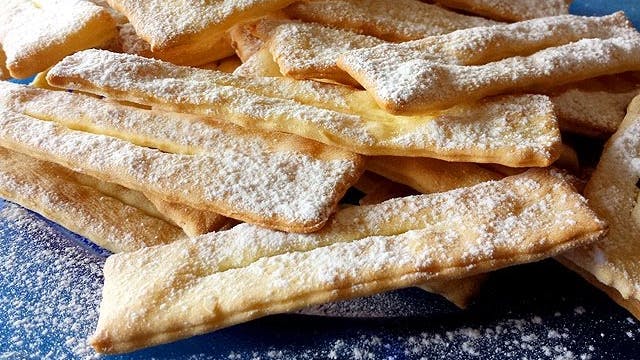

The countdown to the craziest and most fun time of the year has begun: Carnival! It’s the big celebration of the winter weeks preceding Lent, eagerly awaited by everyone, young and old alike. Carnival is all about a riot of masks, streamers, confetti, and (perhaps most importantly) irresistible sweets. Almost always fried, these desserts are a temptation to indulge in at least once a year without too much guilt. Each region has its own traditions, and as we travel across Italy, we encounter castagnole, pignolata, strufoli, migliaccio, to name just a few.
We’re starting to get ready for Carnival with some delicious Chiacchiere, following the recipe of our Cesarina Anna from San Quirico d’Orcia.

The many names of Carnival Chiacchiere
Chiacchiere are one of the most typical Carnival desserts and can be found in every Italian region. Although they are prepared almost everywhere with the same ingredients, their shapes and names vary depending on the area: in central and southern Italy, they are called “chiacchiere”, in Piedmont and Liguria “bugie”, in Marche “sfrappe”, in Emilia ”sfrappole”, in Sardinia “maraviglias”, and on the Romagna coast “fiocchetti”. And these are just a few of the countless ways to refer to this sweet.
Why are they called “Chiacchiere”?
But where does the name "chiacchiere" come from? Legend has it that Queen Margherita of Savoy was chatting pleasantly when she suddenly stopped, overcome by hunger. She then asked her trusted court chef, Raffaele Esposito, to prepare her a dessert. He made her some fritters and, inspired by the situation, presented them under the name "chiacchiere" (chatter).
The Origins of Carnival "Chiacchiere"
Chiacchiere have very ancient origins. They were already being made during Roman times to celebrate the Saturnalia. They were called frictilia: sweets made with eggs and flour and fried in lard. Large quantities were produced because the ingredients were inexpensive and the preparation was very quick. The tradition of frying them in animal fat has been passed down to us, though nowadays it has become common to fry them in oil or, for a lighter version, bake them in the oven.

Chiacchiere
The crispy pastries typical of Carnival
Ingredients
- 300 g all-purpose flour (type 00)
- 40 g sugar
- 2 medium eggs
- 60 g milk
- 30 g melted butter
- 2 tablespoons Vin Santo or rum
- Grated zest of 1 lemon
- A pinch of salt
- Peanut oil for frying
- Powdered sugar for garnish
Method
- Place the flour mixed with sugar and a pinch of salt in a bowl. Make a well in the center and add the eggs, melted butter, lemon zest, and liqueur. Mix the liquids with a fork, starting from the center and gradually incorporating the flour.
- Once the liquids are absorbed and a creamy dough is formed, add the milk. Combine all the ingredients, first using a fork and then continuing by hand, until the dough comes away from the sides of the bowl.
- Form a ball, wrap it in plastic wrap, and let it rest for 30 minutes at room temperature.
- After the resting time, take a small portion of the dough (keep the rest wrapped in plastic), and flatten it with a rolling pin or pasta machine until it reaches a thickness of 2 mm.
- Trim the edges with a fluted pastry wheel and cut the sheet into squares or rectangles.
- Fry the chiacchiere in hot oil, and when golden, drain and place them on paper towels.
- Finish with a dusting of powdered sugar.
The Cesarine Experiences dedicated to Carnival
Confetti, costumes, parades, floats, sweets... in one word: carnival. That magical celebration that captivates both adults and children alike. From strufoli, chiacchiere, frittelle, to castagnole, dive into the best experiences offered by Cesarine, dedicated to the most whimsical weeks of the year, where there's only one rule: have fun!
The Origins of Carnival between Sacred and Profane
The origins of our Carnival go back to ancient times, specifically to the period of ancient Rome, when the Saturnalia were celebrated in February. It was a time of joy, celebrating the fertility of the land, which after the winter dormancy began to nourish both humans and animals again. The spirit of the Saturnalia was very similar to that of our Carnival: banquets, dancing, wearing masks to hide one's identity, and temporarily suspending social hierarchies. In short, it was a time to let loose: after all, the Romans said “semel in anno licet insanire” (“once a year, it is allowed to be crazy”).
The word "Carnival" derives from "carne levare," meaning "to remove meat," and refers to the day before the start of Lent, when people stop eating meat, marking the beginning of the 40 days of fasting before Easter.
From the Middle Ages to Today
Although briefly banned during the reign of Emperor Constantine because it was considered a pagan festival, Carnival continued to brighten the start of each year throughout the Middle Ages, reaching its peak during the Renaissance, when Lorenzo the Magnificent introduced the tradition of masked parades on allegorical floats.

Today, every Italian region has its own Carnival, but some ingredients are always present: colors, joy, and carefree spirit are the main features of every Carnival. Venice hosts Italy’s most famous Carnival, known worldwide for its elaborate masks and finely embroidered costumes, which are real works of art that leave millions of tourists speechless as they crowd the canals to enjoy the spectacle. Viareggio, on the other hand, is known for its magnificent and elaborate allegorical floats, while Ivrea hosts the famous orange battle. Less known to most is the Carnival of Fano, but this Carnival in the Marche region deserves a mention as the oldest in Italy: the first edition dates back to 1347.
